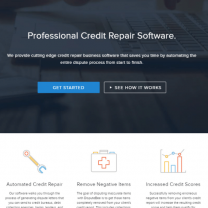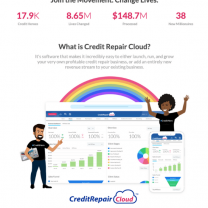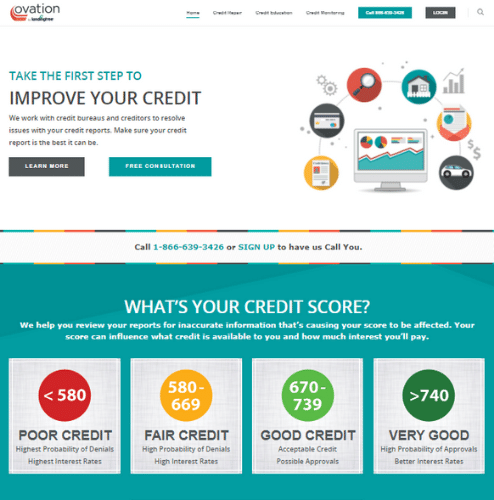How to Fix Bad Credit: Your Step-by-Step Guide to Boost Your Credit Score
If you’re dealing with a low credit score, you’re not alone. Millions of Americans struggle with bad credit, and it can feel like a never-ending cycle that affects everything from getting a loan to renting an apartment. But here’s the good news: fixing bad credit is entirely possible, and you can start today! In this guide, we’ll explore how to fix bad credit, from understanding what affects your score to actionable steps you can take to boost it. We’ll also provide case studies, reviews, and even some useful YouTube videos to guide you on this journey.
What Causes Bad Credit and Why Should You Fix It?
What Causes Bad Credit and Why Should You Fix It?
Before diving into how to fix bad credit, it’s important to understand what causes a low credit score in the first place. Credit scores range from 300 to 850, with anything below 580 considered poor. A variety of factors can contribute to a low score, including:
- Late Payments: Missing payments on credit cards, loans, or bills can significantly impact your score.
- High Credit Utilization: Using too much of your available credit limit is seen as a red flag by lenders.
- Collections or Charge-offs: Accounts that are sent to collections or charged off by creditors can drop your score.
- Bankruptcy or Foreclosure: These are severe financial setbacks that can remain on your credit report for up to 10 years.
- Errors on Your Credit Report: Incorrect information, such as accounts that don’t belong to you, can also affect your score.
Why Should You Fix Bad Credit?
- Better Loan and Credit Card Terms: Higher scores can qualify you for lower interest rates.
- Easier Approval for Rentals: Many landlords check credit scores when you apply for a lease.
- Lower Insurance Premiums: Some insurance companies use credit scores to determine rates.
- Increased Financial Freedom: A good credit score opens up more financial opportunities.
How to Fix Bad Credit: Step-by-Step Process
Now that we understand why it’s important to fix bad credit, let’s explore the steps you can take to improve your credit score.
Step 1: Check Your Credit Reports for Errors
The first step in fixing bad credit is to check your credit reports for errors. You can obtain free credit reports from the three major credit bureaus (Experian, Equifax, and TransUnion) once a year at AnnualCreditReport.com.
- What to Look For: Incorrect personal information, accounts that don’t belong to you, incorrect payment statuses, duplicate accounts, or outdated information.
- How to Dispute Errors: If you find any inaccuracies, dispute them directly with the credit bureau. Most credit bureaus allow you to dispute errors online, by phone, or by mail.
Step 2: Pay Your Bills on Time
One of the most impactful ways to fix bad credit is to start paying your bills on time. Payment history accounts for 35% of your credit score, so making consistent, on-time payments will help improve your score over time.
- Tip: Set up automatic payments or use reminders on your phone to ensure you never miss a due date.
- What If You Can’t Afford to Pay? Contact your creditors immediately. Many companies offer hardship programs or payment plans that may help you avoid late payments.
Step 3: Reduce Your Credit Card Balances
Another key factor in how to fix bad credit is managing your credit utilization ratio, which is the amount of credit you’re using compared to your credit limit. Ideally, you should aim for a utilization ratio of 30% or lower.
- Action Plan: Focus on paying down high-interest debt first. Consider using the snowball method (paying off the smallest debt first) or the avalanche method (paying off the debt with the highest interest rate first).
- Why This Matters: Lowering your credit utilization ratio can significantly boost your credit score in a relatively short amount of time.
Step 4: Don’t Close Old Credit Accounts
While it might seem like closing old or unused credit accounts could help your credit, it actually does the opposite. Closing an account can lower your overall credit limit, which can increase your credit utilization ratio.
- Pro Tip: Keep old accounts open, especially if they have a long, positive payment history. This can help improve your score over time.
- What If You Have to Close an Account? If you must close an account, try to close newer accounts first to preserve your average account age.
Step 5: Consider a Secured Credit Card
If you’re struggling with bad credit, a secured credit card can be a great way to rebuild your credit. Secured credit cards require a cash deposit, which serves as your credit limit. Using a secured credit card responsibly by making on-time payments and keeping your balance low can help you build a positive payment history.
- How It Works: Apply for a secured credit card with a reputable bank. Make small purchases each month and pay off the balance in full.
- Why It Helps: This demonstrates to lenders that you are responsible with credit, which can gradually improve your score.
Step 6: Negotiate with Creditors
If you have accounts in collections or past due, consider negotiating with your creditors. Many creditors are willing to settle for less than the full amount owed, or they might agree to remove a negative item from your report in exchange for payment.
- How to Negotiate: Contact your creditor directly and explain your situation. Be polite but firm, and ask if they are willing to settle or remove the negative item from your report.
- Potential Outcome: Some creditors might agree to a “pay for delete” arrangement, where they remove the negative item once the debt is paid.
Step 7: Use Professional Credit Repair Software
Using professional credit repair software can simplify and accelerate the process of fixing bad credit. Software like Credit Repair Cloud, DisputeBee, or Credit-Aid can help you identify errors, generate dispute letters, and track your progress.
- How It Works: These tools automate much of the credit repair process, from identifying errors on your report to generating dispute letters.
- Why It’s Useful: Credit repair software can save you time and ensure that your disputes are handled efficiently and correctly.
Case Studies: Real-Life Examples of How to Fix Bad Credit
Case Study 1: John’s Journey from 580 to 700 in Six Months
Meet John, a 45-year-old small business owner from Florida. John had a credit score of 580, largely due to late payments and a high credit utilization ratio. After realizing how much his bad credit was costing him in high-interest rates, he decided to take action.
- What He Did:
- Checked Credit Reports: Found two errors – a collection account that didn’t belong to him and an incorrect late payment.
- Disputed Errors: Used Credit Versio software to generate dispute letters and successfully removed both errors.
- Paid Down Debt: Focused on paying down his credit card balances to reduce his credit utilization ratio.
- Set Up Automatic Payments: Ensured all future payments were made on time.
- Outcome: John’s credit score improved from 580 to 700 in just six months, allowing him to refinance his mortgage at a much lower interest rate.
Takeaway: Taking a proactive approach to disputing errors and managing debt can lead to significant improvements in your credit score in a relatively short period.
Case Study 2: Lisa’s Path to Recovery After Bankruptcy
Lisa, a 35-year-old from California, had filed for bankruptcy three years ago and was struggling with a credit score of 540. Determined to rebuild her credit, she followed a strict credit repair plan.
- What She Did:
- Applied for a Secured Credit Card: Used it to make small purchases and paid off the balance in full each month.
- Negotiated with Creditors: Reached settlements on old debts still showing as unpaid on her credit report.
- Monitored Her Progress: Used Credit Karma to monitor her credit score monthly.
- Outcome: Within a year, Lisa’s credit score increased by 120 points, and she was able to qualify for a car loan with a reasonable interest rate.
Takeaway: Even after a major financial setback like bankruptcy, it is possible to rebuild your credit with patience, diligence, and the right strategies.
What Are People Saying About Fixing Bad Credit?
User Reviews on How to Fix Bad Credit
-
Emma, New York: “I was stuck with a score of 600 for years. Once I started using professional credit repair software, it made the whole process so much easier. I’m now at 720 and just bought my first home!”
- Source: Trustpilot
-
James, Texas: “Paying my bills on time and reducing my credit card balances helped, but disputing the errors on my report made the biggest difference. I couldn’t believe how fast my score went up!”
- Source: Consumer Affairs
How Long Does It Take to Fix Bad Credit?
The time it takes to fix bad credit varies depending on several factors, such as the number of errors on your report, the severity of the negative items, and how quickly the credit bureaus respond to your disputes. In general:
- Minor Issues: 30-60 days to see initial improvements.
- Moderate Issues: 3-6 months for noticeable changes.
- Severe Issues (e.g., bankruptcy): 12 months or more to rebuild a damaged credit score.
Frequently Asked Questions
How can I fix bad credit quickly?
Is it possible to fix bad credit on my own?
How long does it take to fix bad credit?
It can take anywhere from 30 days to several years, depending on the severity of the issues on your credit report.
Will paying off debt improve my credit score?
Yes, paying off debt can improve your credit score by reducing your credit utilization ratio and showing responsible credit management.
Can I fix bad credit after bankruptcy?
Yes, you can rebuild your credit after bankruptcy by using strategies like obtaining a secured credit card, making timely payments, and monitoring your credit report for errors.
Does closing old credit accounts help fix bad credit?
No, closing old credit accounts can actually hurt your credit score by reducing your available credit and shortening your credit history.
Should I hire a credit repair company to fix bad credit?
Hiring a credit repair company can help if you’re short on time or unsure how to handle disputes, but it’s often more cost-effective to use professional credit repair software or handle it yourself.
What’s the best way to start fixing bad credit?
Check Out These YouTube Videos to Learn More About Fixing Bad Credit:
- How to Fix Bad Credit Fast – A step-by-step guide to repairing your credit quickly.
- Credit Repair Tips: Top 5 Ways to Improve Your Credit Score – An expert breakdown of the most effective strategies for fixing bad credit.
Final Thoughts: How to Fix Bad Credit and Take Control of Your Financial Future
Fixing bad credit is not an overnight process, but with the right strategies and tools, you can see significant improvements in your score. Start by checking your credit report, disputing any errors, and making on-time payments a priority. Consider using professional credit repair software like Credit Repair Cloud or DisputeBee to simplify the process and track your progress.
Remember, rebuilding your credit takes time, but every step you take brings you closer to financial freedom. Ready to start your journey to a better credit score? Visit CreditRepairDetails.com for more resources and tools to help you achieve your credit goals!





